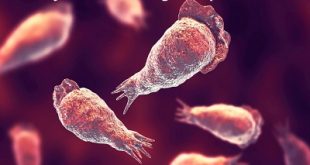Introduction
Pellagra is a disorder due to inadequate dietary intake of niacin and/or tryptophan, manifested by a characteristic dermatitis on areas of the skin that are exposed to the sun, beginning as an erythema with pruritus that may lead to vesticulation but more frequently becomes chronic, rough, scaly, and hard with the formation of crusts as the result of haemorrhage; a broad band of this dermatitis frequently encircles the neck.
Rough skin in hands and legs
The digestive tract and nervous system may be involved, with glossitis, stomatitis, gastroenteritis, diarrhoea with profuse watery and sometimes bloody stools, anxiety, depression, tremor, and reduced or absent tendon reflexes; encephalopathy may occur in severe cases. The disease is classically associated with a diet based on non-alkali-treated maize.
What is Niacin?
Niacin is a pyridine carboxylic acid that is converted into an amide in the body. Nicotinamide is a natural derivative of niacin. Niacin is required for adequate cellular function and metabolism as an essential component in coenzyme I (the oxidized form of nicotinamide adenine dinucleotide – NAD) and coenzyme II (the reduced form of nicotinamide adenine dinucleotide phosphate – NADP), which either donate or accept hydrogen ions in vital oxidation-reduction reactions.
These compounds are important coenzymes for glycolysis, protein and amino-acid metabolism, pyruvate metabolism, pentose biosynthesis, generation of high-energy phosphate bonds, glycerol metabolism, and fatty acid metabolism. As cellular functions in multiple organs and tissues are affected by niacin deficiency, the clinical expression of pellagra is diverse.
History behind Pellagra
The earliest description of pellagra was that of the Spanish physician Don Gaspar Casal in 1763. Casal recorded all the clinical characteristics and described the disease to the unbalanced diets, based on maize, of poor peasants in the Asturia region of Spain.
The next description of the disease came from Italy in 1771 when pellagra was given its name, meaning “rough skin”. The disease continued to be widespread in Italy throughout the nineteenth century.
Pellagra outbreaks followed the introduction of maize into Europe from its original home in the New World. It spread through Europe from Spain to Italy, France, central Europe, Romania, Turkey, Greece and parts of southern Russia. It also followed in the wake of maize introduction into Egypt and later into central and southern Africa.
There has been no evidence of pellagra among the indigenous peoples of North, Central and South America where maize was domesticated and has been the staple cereal for thousands of years. After 1900, pellagra decreased greatly in Italy for reasons that are unclear, and by 1916 the disease had almost disappeared in the country. However, it remained a serious problem in parts of southeastern Europe until World War II.
After 1906, pellagra also became a serious problem in many southern parts of the United States, affecting tens of thousands of people.
Pellagra declined sharply between 1930 and 1933 mainly due to improved agricultural and economic conditions in the country. In the 1960s and 1970s pellagra was still considered a public health problem in many countries.
Prevalence and Incidence
The current incidence of pellagra in the United States and other countries is unknown. Epidemics of pellagra are no longer evident. Sporadic cases of pellagra occur among chronic alcoholics, food faddists or people dependent on drugs and patients with malabsorption states. Pellagra occurs chiefly in developing nations where corn and corn products are the major food source or in ethnic populations with diets deficient in niacin/tryptophan. Typically, pellagra is an adult disease, with no sexual or racial predilection. It rarely occurs during infancy. Adolescents and young children can develop pellagra if they have a faulty diet. In the past, kwashiorkor has been mistaken as infantile pellagra.
Causes of pellagra
Pellagra is caused by a deficiency in niacin. This can occur in 2 ways:
Primary pellagra results from inadequate niacin and/or tryptophan in the diet (mainly in developing countries or poverty stricken areas)
Secondary pellagra occurs when there is enough niacin in the diet but something prevents its absorption and processing. Causes of secondary pellagra include:
- Chronic alcoholism
- Prolonged diarrhoea
- Gastrointestinal diseases such as ulcerative colitis
- Liver cirrhosis
- Carcinoid tumours
- Hartnup disease (tryptophan metabolism disorder)
- Drugs e.g. isoniazid, azathioprine
What are the risk factors?
A number of factors increase the risk of developing pellagra. Not all people with risk factors will get pellagra. Risk factors for pellagra include:
- Alcoholism
- Anorexia nervosa
- Diets high in corn
- Vegetarian / vegan diet – people who are on a strict vegetarian or vegan diet may become more easily deficient in vitamin B3 (niacin) as the foods that contain high levels are chicken, beef and fish
- Digestive disease
- Low dietary intake of tryptophan (needed to produce niacin in the body)
What are the signs and symptoms of pellagra?
The classical triad of symptoms are diarrhoea, dermatitis and dementia.
| Site | Clinical features |
| Skin | · The first sign is reddened skin with superficial scaling in areas exposed to sunlight, heat and friction. This may resemble severe sunburn then gradually subsides leaving a dusky brown-red colouration
· The rash is usually symmetrical with a clear edge between affected and unaffected skin · There may be itching or a burning sensation · In time the skin becomes thick, hard, scaly and cracked. Bleeding may result in blackened crusts · Lesions may occur anywhere on the body especially the hands, arms, lower legs, feet, face, and neck (known as Casal’s necklace) Lips, tongue and gums may be sore and peeling |
| Gastrointestinal | · Diarrhoea occurs in 50% of cases
· Poor appetite, abdominal pain, nausea and vomiting are common · It may be difficult to eat and drink, leading to further malnutrition |
| Neurological | · Initially symptoms of apathy and slight depression may go unnoticed
· Other symptoms include headache, confusion, irritability, restlessness, anxiety, tremor, delusions, disorientation and psychosis · Patients eventually become stuporous, comatose and may die |
| Oral findings | · Tongue and mouth soreness as a result of mucous membrane inflammation, often with edematous swelling of the apex and edges, is aggravated by highly seasoned. |
What are the potential complications of pellagra?
Complications of pellagra include:
- Dementia
- Depression
- Anxiety
Diagnosis of pellagra
Initial diagnosis of pellagra involves the following:
- Medical history of symptoms – the doctor will ask a series of questions about severity and duration of symptoms, including the onset, to determine if there is a risk factor of pellagra
- Physical examination – the doctor will perform a physical examination to determine if there are any obvious physical symptoms of pellagra
If the conditions warrant and to confirm diagnosis the following tests are requested:
- Blood test – this will test for blood levels of vitamin B3 (niacin), as well as levels of red and white blood cells and any other factors the doctor deems necessary
Treatment and Medications
- Oral supplementation with nicotinamide is usually used (eg. 100-200 mg three times a day until symptoms remit).
- Nicotinamide is used in preference to nicotinic acid, as side-effects relating to vasodilatation are fewer – eg, flushing.
- Cutaneous lesions begin to resolve in 24-48 hours after starting treatment.
- Bedrest is mandatory in treating patients with severe pellagra. Patients should avoid sun exposure during the active phase of the disease.
Home remedies to cure pellagra
- Drink Orange Juice
- Include Multiple Vitamin B3 Rich Foods
Vitamin B3 rich foods
- Stay Hydrated
- Eat Pumpkin Seeds & Spinach: Spinach is high in calcium, iron and folate that together compensate the deficiency of vitamins observed in pellagra patients.
- Oats
- Milk and Milk Products: Milk is effective in curing pellagra and its prevention. Milk is rich in niacin, B complex vitamins and calcium.
- Eggs: Daily consumption of eggs is being recommended for those suffering from pellagra as it replenishes the body with niacin and improves symptoms of pellagra.
- Spirulina is algal supplement that is rich in number of vitamins including B vitamins that are essential for treating pellagra.
- Meat is rich in high levels of proteins that are crucial for niacin production in the body. Niacin is present in direct form in meat too.
- Lavender (For Topical Application)
- Broccoli
- Aloe Vera
- Coriander Leaves
- Fenugreek Seeds
- Fish (Cooked Yellowfin Tuna) and Ginger
- Chicken Soup
- Asparagus and Beef
Prevention and control of Pellagra
- Eating foods rich in tryptophan, which plays a role in making niacin, such as seafood, meat, yeast, eggs, bran, peanuts green vegetables, whole-grain cereals, legumes and seeds.
- Recommended daily allowance are as follows:
- Infants – 5 to 6 mg
- Children – 9 to 13 mg,
- Adults – 13 to 20 mg
- Pregnant – 17 mg
- Lactating mothers – 20 mg
- Optimal supplementation is 20 to 30 mg daily
- Ensuring your diet is rich in foods that contain niacin, such as cereal grains, eggs, green vegetables, fish, milk and yeast
- Following a healthy food plan that includes a variety of foods from each of the food groups
- Practicing moderation if you drink alcohol
- For secondary prevention one should avoid sun exposure during the active phase of the disease.
- Close dietary follow up of the patient upon recovery helps prevent recurrence of pellagra.
- Adequate Rest: Rest is very beneficial in curing pellagra as stress is bound to worsen the symptoms and complicate the pellagra condition. Take adequate rest and do not indulge in stressful acts to prevent aggravation of itching,
 Diseases Treatments Dictionary This is complete solution to read all diseases treatments Which covers Prevention, Causes, Symptoms, Medical Terms, Drugs, Prescription, Natural Remedies with cures and Treatments. Most of the common diseases were listed in names, split with categories.
Diseases Treatments Dictionary This is complete solution to read all diseases treatments Which covers Prevention, Causes, Symptoms, Medical Terms, Drugs, Prescription, Natural Remedies with cures and Treatments. Most of the common diseases were listed in names, split with categories.








Thank you for another informative web site. The place else may just I am getting that type of info written in such a perfect manner? I have a mission that I am just now working on, and I have been at the glance out for such information.
This design is wicked! You obviously know how to keep a reader entertained. Between your wit and your videos, I was almost moved to start my own blog (well, almost…HaHa!) Wonderful job. I really enjoyed what you had to say, and more than that, how you presented it. Too cool!
I really appreciate this post. I have been looking all over for this! Thank goodness I found it on Bing. You have made my day! Thank you again
My brother recommended I might like this web site. He was entirely right. This post truly made my day. You cann’t imagine just how much time I had spent for this info! Thanks!